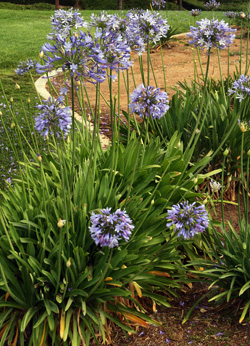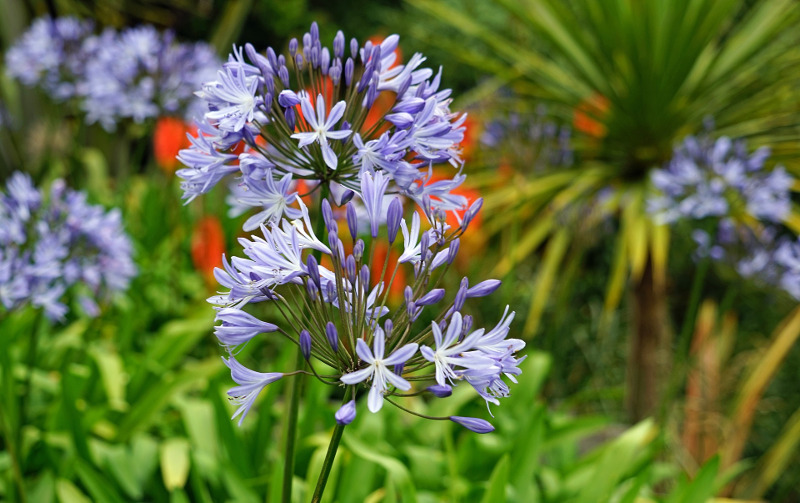Sensational Agapanthus: Enhancing Your Garden's Charm
Wiki Article
Letting Loose the Secret to Effective Agapanthus Growing: Idea for a Flourishing Garden
In the world of horticulture, growing agapanthus efficiently requires a strategic technique that encompasses numerous facets of plant care. With cautious interest to detail, one can unlock the tricks to nurturing these stunning blooms, resulting in a yard that grows with beauty and vibrancy. By understanding the nuances of agapanthus growing, one can develop an atmosphere where these plants flourish and flower generously. In the adhering to discussion, we will certainly explore important ideas and techniques that will certainly lead you towards a growing agapanthus yard, offering insights right into best techniques, dirt problems, sprinkling strategies, and extra.Planting Agapanthus: Ideal Practices
When growing Agapanthus, appropriate dirt preparation is important for guaranteeing effective growth and growth of these beautiful flowers. Agapanthus, commonly called Lily of the Nile or African lily, thrives in well-draining dirt with a slightly acidic to neutral pH level - Agapanthus. Prior to growing, it is important to modify heavy clay dirts with raw material such as compost or peat moss to enhance water drainage and offer vital nutrients for the plantsTo plant Agapanthus, pick a location that gets full sunlight to partial shade, as this will promote healthy and balanced development and plentiful blooming. Dig an opening two times the diameter of the plant's root ball and position the Agapanthus at the exact same depth it was formerly growing. Delicately backfill the hole with soil, weighing down strongly to get rid of any air pockets around the roots.
Water the freshly planted Agapanthus completely and remain to maintain the dirt equally moist, specifically during the plant's active expanding period. Agapanthus. Applying a balanced fertilizer once a month can even more support the plant's development and blooming. By adhering to these best practices for planting Agapanthus, you can produce a magnificent display screen of these exciting blossoms in your garden
Perfect Dirt Issues for Agapanthus
For optimum growth and flowering success of Agapanthus plants, guaranteeing the soil conditions are suitable is essential. Agapanthus prefers soil that is rich in nutrients, so incorporating a well balanced fertilizer during the growing period can advertise healthy and balanced growth and vibrant blossoms.
Watering and Feeding Tips
To make certain healthy and balanced growth and vibrant flowers, correct watering and feeding strategies are essential for successful Agapanthus farming. Agapanthus plants take advantage of regular watering, especially during the growing period. It is advised to water deeply when a week, making sure the soil is damp however not waterlogged. Throughout heat or in pots, even more frequent watering might be essential to stop the dirt from drying totally.When it pertains to feeding Agapanthus, a balanced fertilizer with equal components nitrogen, phosphorus, and potassium can be used in the spring to promote healthy and balanced growth and blooming. Slow-release plant foods are perfect for giving nutrients progressively over an extensive period. Avoid over-fertilizing, as this can lead to excessive foliage development at the expense of blooms.
In addition, integrating raw material like garden compost into the dirt can boost nutrient degrees and improve dirt structure, aiding in the total health of the Agapanthus plants. By adhering to these watering and fertilizing pointers, gardeners can guarantee their Agapanthus plants prosper and produce sensational screens of blossoms.
Trimming and Deadheading Methods
Proper pruning and deadheading strategies play a critical function in maintaining the wellness and visual appeals of Agapanthus plants, complementing the crucial methods of watering and feeding for successful growing. Trimming Agapanthus involves eliminating spent flower heads, dead or yellowing leaves, and total shaping of the plant to promote much better development. Deadheading, the process of eliminating discolored flowers, not only boosts the plant's look yet likewise encourages additional growing.When deadheading Agapanthus, it is suggested to trim off the flower stem at the base utilizing sharp, clean shears. This process redirects the plant's energy from seed production back into origin and vegetation development, promoting a much healthier and extra durable plant. Regular deadheading can go to my site prolong the growing period of Agapanthus and avoid self-seeding, which can result in congestion.
In regards to trimming, Agapanthus generally take advantage of a light trim after blooming to tidy up the plant and motivate fresh development. Reducing the invested blossom stems and getting rid of any type of dead or damaged vegetation helps maintain the plant's vitality and total appearance. Nonetheless, it is vital to avoid cutting into the crown of the plant, as this can damage its health.

Protecting Agapanthus From Vermins and Diseases
Implementing reliable pest and illness management methods is essential to safeguarding the wellness and vitality of Agapanthus plants in growing. One usual pest that impacts Agapanthus is the Agapanthus borer, a caterpillar that tunnels into the plant, triggering damages to the blossoms and fallen leaves.In addition to pests, Agapanthus are vulnerable to diseases such as useful site origin rot and fungal leaf areas. By staying alert and resolving parasite and disease issues promptly, gardeners can help their Agapanthus flourish and flourish.

Verdict
To conclude, successful farming of agapanthus requires appropriate planting strategies, perfect dirt conditions, ample watering and fertilizing, routine pruning and deadheading, and protection from diseases and bugs. By following these methods and suggestions, gardeners can guarantee a prospering yard loaded with gorgeous agapanthus blossoms. Agapanthus. Remember to preserve regular treatment and attention to information to advertise the wellness and longevity of these spectacular plantsWhen growing Agapanthus, proper soil prep work is vital for guaranteeing successful development and development of these attractive flowers.Water the recently grown Agapanthus extensively and proceed to maintain the dirt evenly moist, specifically throughout the plant's energetic expanding period.For optimum development and flowering success of Agapanthus visit site plants, making sure the dirt problems are perfect is critical. When planting or transplanting Agapanthus, guarantee the dirt is well-prepared to offer the needed foundation for the plants to establish themselves efficiently. One usual pest that affects Agapanthus is the Agapanthus borer, a caterpillar that tunnels into the plant, triggering damage to the fallen leaves and blossoms.
Report this wiki page